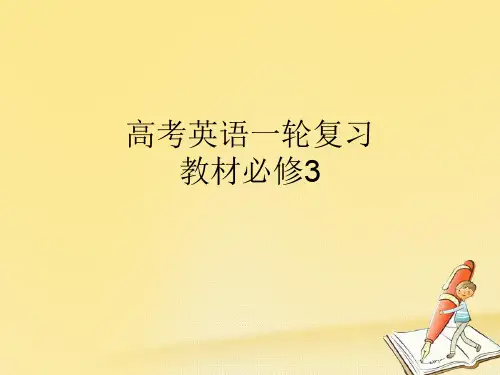高中英语 Unit1 Grammar1 重庆大学版必修3
- 格式:ppt
- 大小:418.50 KB
- 文档页数:18
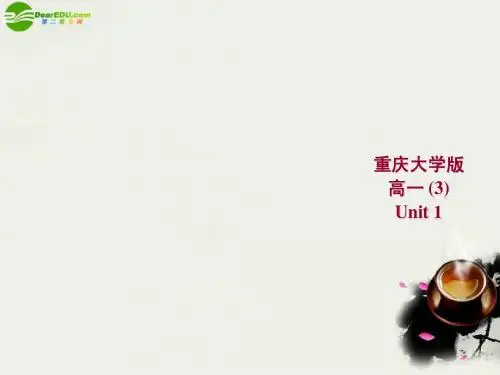

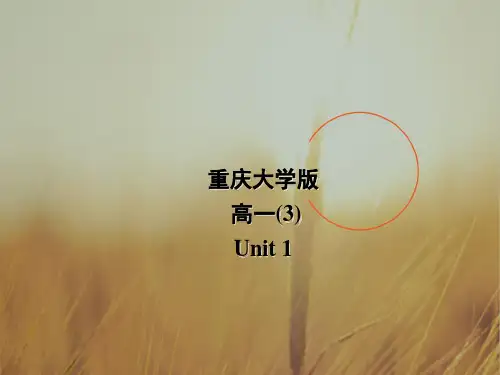

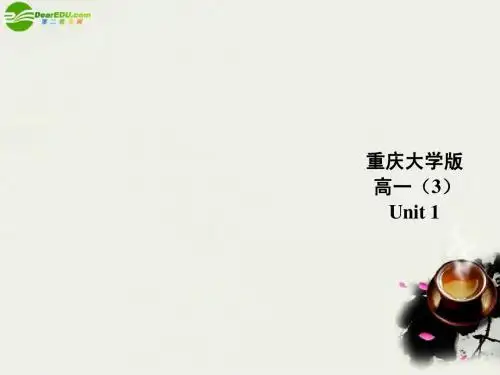

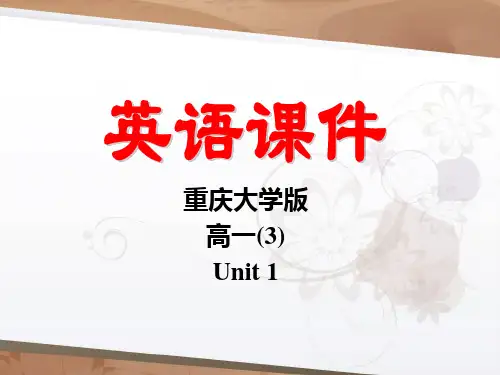

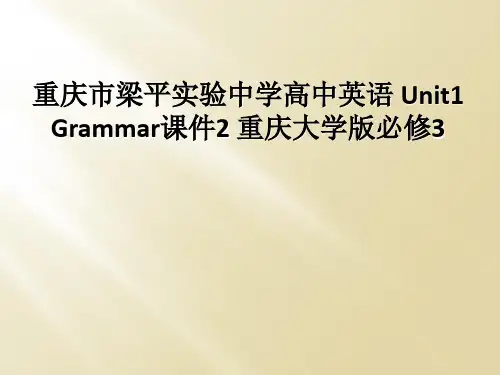

《高中英语(上外版)》必修第三册Unit 1 Road to Success课时:第3课时课题:Grammar in Use课型:语法课教学设计与说明一.学情分析本节课授课对象为高一第二学期的学生。
经过第一学期的学习,同学们已经有了分词在句子中各项功能的总体概念。
但是大部分同学们对分词各项句法功能的总体框架结构是不清晰的,对分词的各项句法功能各自的特点、重点、难点没有概念。
所以需要帮助学生分项理清特点、重点、难点,并在语言实际交际运用中加以操练并巩固。
二.教材分析单元语法运用Grammar in Use聚焦于分词作补语(宾语补足语和主语补足语)的复习和巩固。
教材P9-10上有三道语法练习题。
第一题旨在分析分词在句子中的功能,认识分词做补语的结构。
第二题旨在辨认分词作补语的结构并能正确区分这一结构中现在分词和过去分词在做补语时的区别。
第三题考查语言的综合运用能力,要求学生在语篇中、在上下文语境中理解、分析、归纳并灵活运用分词作补语这一语法功能,同时要求学生区分分词作补语与分词其它功能的区别。
三.教学设计思路本课为本单元语法教学的第二课时:语法练习课,旨在帮助学生在第一节语法课的基础上复习巩固分词作补语这一语法功能,并为学生创设产出的机会,提高语用能力。
导入部分利用课本P8-9练习I&II,采用归纳演绎教学法复习第一课时学习过的内容,引导学生学会对学过的语法规则进行分类归纳,在头脑中形成非谓语知识体系的网络架构。
操练部分采用任务型教学方法,在遵循学生认知规律的基础上设置多层次能力要求逐步递进的实践任务,引导学生在完成各个层次的任务中逐步实现分词做补语这一语法功能的内化,并在任务中实现learning by using, learning for using的语法学习目标。
Lesson Plan(the 3 period)rdLearning Objectives:By the end of the period, the students are expected to:1. have the ability of classifying and summarizing grammar rules of -ing / -ed forms as complements;2. form the network of -ing / -ed forms as complements in mind so as to distinguish them from other functions of -ing / -ed forms;3. skillfully apply -ing / -ed forms as complements in listening, reading and writing.Learning Procedures:Step I. Revision (Interactive activity)*T: Help the students recall and classify what they learned in the first period of Grammar in Use with the help of Exercise I & II on P 8-9.*Ss: Recall the grammatical rules of -ing / -ed forms used as complements by category.I. -ing form used as complements:feel / hear / listen to / see / watch / look at / notice / observe ... + O. + doing (O. C.)S.+ be felt / heard ... + doing (S. C.)discover / find / smell / catch ... + O. doing (O. C.)S. + be + discovered ... + doing (S. C.)get / have / keep / leave / send / set / start ... + O. doing (O. C.)with + O. + doing (O. C.)II. -ed form used as complements:see / hear / watch / find / feel / consider ...+ O. + done (O. C.)S.+ be seen ... + done (S. C.)get / have / keep / leave / make ... + O. + done (O. C.)declare / like / need / order / want / wish ... + O. + done (O. C.)with + O. + done (O. C.)Note: After working non-stop for twenty hours, he went to bed tired and hungry. (O. C.) The athlete went away quite satisfied with the result of the match. (O.C.)Step II. PracticeI. Identify - ing /- ed forms as complements in the lyrics (Task 1)*T: Play the song “Those Sweet Words” and ask students to identify - ing /- ed forms as complements in the lyrics while enjoying the melody. And then focus on the functions of -ing / -ed forms in “Iknow I saw you saying it.” and “I just h ave to hear t hose sweet words s poken like a melody.” and the meanings of the two sentences.*Ss: Identify - ing /- ed forms as complements and translate the two sentences into Chinese.Those Sweet WordsBy Norah JonesWhat did you sayI know I saw you saying itMy ears won't stop ringingLong enough to hearThose sweet wordsWhat did you sayAnd now the dayThe hour hand has spunBefore the night is doneI just have to hearThose sweet wordsSpoken like a melodyAll your love...II. Apply -ing / -ed forms as complements in individual sentences. (Task 2)*T: Ask students to identify the structure of -ing / -ed forms as complements in the following sentences and then fill in the blanks with proper forms of the verbs given in the box. Call students’attention to the differences between -ing forms as complements and -ed forms as complements.*S: Read the sentences silently and underline the structure of -ing / -ed forms as complements in each sentence and then fill in the blanks with -ing forms or -ed forms based on grammar rules of the differences between -ing forms as complements and -ed forms as complements.III. Apply -ing / -ed forms as complements in a passage. (Task 3)*T: Ask students to read a short passage and fill in the blanks with the -ing / -ed forms of the verbs given in the box. Then circle the ones that are used as complements. Call students’ attention to the differences between -ing / -ed forms as complements and -ing / -ed forms for other functions.*S: Read the short passage silently and circle the structures of -ing / -ed forms as complements in the passage and then fill in the blanks with -ing forms or -ed forms based on grammar rules of the differences between -ing / -ed forms as complements and -ing / -ed forms for other functions.IV. Apply -ing / -ed forms as complements in writing sentences. (Task 4)*T: Ask students to read each sentence in Chinese carefully and make out which category of -ing / -ed forms as complements fits the contexts best based on the given word in the brackets. And then translate the whole sentence into English.*S: First, make out and write down the proper structure of -ing / -ed forms as complements. Then, translate the whole sentence into English.。
